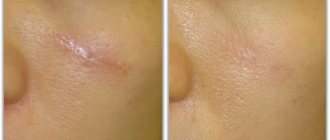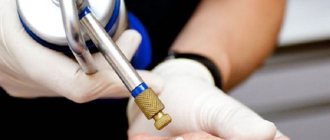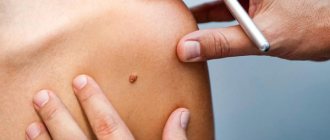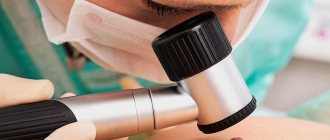The laser method of removing tumors with minimal trauma to the skin ensures complete elimination of papillomas, warts, nevi and other blemishes. It can be a single tumor or a whole scattering - the laser eliminates problems of any scale. Targeted effects, speed of the procedure and comfortable recovery after it - all this makes laser removal a very popular service.
At the Medial clinic you can remove any tumor. If necessary, we will send the material for histological examination. If the doctor deems it necessary, histology will need to be done before the procedure.
How is the procedure to remove tumors performed?
1. Consultation.
Even if you have already been to our clinic, the doctor must conduct an examination and ask you clarifying questions. If there are no obstacles to removal, you go to the treatment room.
2. Pain relief.
For these purposes we use local anesthesia. Usually these are injections. A cream with anesthetics is also used - everything is individual.
3. Equipment setup.
The doctor determines the power of laser radiation.
4. The procedure itself.
The laser targets the neoplasm without damaging healthy skin. If your face is being treated, you will be asked to wear special safety glasses. Laser removal of skin tumors takes from 5 minutes to an hour, depending on the amount of work.
The laser seals the blood vessels, which prevents bleeding and infection. At the end of the session, you receive the doctor's recommendations and leave the clinic. Full recovery requires an average of 7 days.
Recovery period
The first 2-3 days.
It is necessary to treat the removal site with antiseptics / other means prescribed by the doctor. The wound should not be wetted.
The first two weeks.
You cannot steam your skin; swimming pools, saunas, and swimming in the sea are prohibited. Low temperatures are also undesirable. Do not rub the wound with a towel or try to pick off the scab.
First month.
Sunbathing is not recommended to avoid pigmentation. When going out in the sun you need to use sunscreen.
Complications:
- Inflammation;
- Scars (including keloids);
- Hyperpigmentation.
The recommended protocol for the procedure and following the doctor’s advice will save you from unpleasant consequences.
Is preparation necessary?
Even the removal of a small skin tumor is considered a full-fledged surgical intervention. For this reason, before surgery, it is mandatory to undergo a preoperative examination, which includes:
- General blood and urine analysis.
- Blood test for clotting.
- Blood test for HIV, hepatitis and syphilis.
- Electrocardiogram.
- Fluorography.
- Consultation with an oncologist.
- A certificate from a physician stating that there are no contraindications to surgery.
Remember that each case is individual. In some situations, the doctor may prescribe additional types of examination.
Some preparation will be required for the intervention itself:
- If excess vegetation is observed in the area of the new growth, it is recommended to carefully remove it.
- On the eve of the study, the necessary hygienic procedures should be carried out.
- If you experience fear or anxiety before the procedure, consult your doctor about taking sedatives.
- Tell your doctor about all medications you take on a regular basis, including vitamins.
Types of benign neoplasms
1. Warts, papillomas.
New growths protruding above the surface of the skin ranging in size from 1 mm to 2 cm. The former are more often found on the hands and feet, the latter can occur in different parts of the body, including in the intimate area.
2. Nevi (moles).
Pigmented spots. Sometimes they rise above the surface of the skin, sometimes they are at its level. They can cause inconvenience if they are in places such as the face, armpits, and bikini area. Many patients consider them an aesthetic defect.
3. Keratomas.
This neoplasm has a rough surface and rises slightly above the skin.
4. Atheromas.
In other words, sebaceous gland cysts. They can reach up to 20 cm in diameter!
5. Genital condylomas.
Benign neoplasms arising from the human papillomavirus (HPV).
6. Cotagious molluscs.
They appear on the face and body due to contact with a sick person or through objects. You can become infected in the pool or in other public places.
7. Xanthelasma of the eyelids.
Most often found in patients with diabetes and obesity. Most people with this problem are female.
8. Fibroids.
Tumors formed from connective tissue.
9. Hemangiomas.
Vascular tumors that can reach very large sizes (port-wine stains).
We have not listed all types; these are the most common problems with which our doctors are contacted. Removal of benign skin tumors is carried out only after consultation. If the doctor suspects that the patient has cancer, we will refer you to an oncologist to obtain an opinion. Medial doctors will never perform an extraction if the procedure could be dangerous to your health.
Rehabilitation period
As a rule, a couple of hours after surgery, the patient can go home. To reduce the risk of complications and undesirable consequences, it is recommended to follow the following rules:
- Daily dressing change, antiseptic wound treatment.
- For prevention purposes, the doctor may prescribe antibacterial or anti-inflammatory drugs.
- In order to speed up wound healing, regenerating ointments or creams can be prescribed.
- For 10 days after surgery, it is recommended to avoid increased physical activity, taking baths, visiting bathhouses and swimming pools.
More detailed information about the excision of tumors of the skin and subcutaneous tissue can be obtained during an in-person consultation with a specialist. Be healthy!
Removal of tumors on the face with laser
Removing benign formations on the face and neck is a very painstaking and responsible job. When getting rid of these imperfections, the patient does not want scars to appear in their place. The advantage of the laser is the ability to remove nevi, papillomas, and hemangiomas effectively and without leaving a trace.
Working on thin skin, the laser does not harm it - the impact is concentrated only on a specific area. Therefore, you can easily get rid of imperfections:
- in the corners of the eyes and on the eyelids;
- on the temples;
- on and around the lips;
- on the neck.
Redness and crusting after the session are a normal reaction. When tissue repair is complete, the skin will even out. Over time, no one will notice with the naked eye that the removal procedure was carried out.
Causes of benign tumors
The reasons for the appearance of benign neoplasms can be different. As a rule, there are hereditary factors that trigger the mechanism of tumor appearance and those associated with external influences and a person’s lifestyle. However, in most cases the cause remains unknown. But you should not worry about this, since this does not affect the prognosis and treatment results in general.
The formation of a benign tumor can occur due to:
- poor heredity, fetal development disorders;
- negative effects of physical factors, ionizing radiation: radiation, x-rays;
- contact of the human body with toxic substances;
- constant stress;
- infections, various inflammatory processes;
- poor diet with a lot of fat, red meat, sugar in the diet, lack of vegetables and seasonal fruits;
- acute injuries or systematic tissue damage (this can be long-term mechanical impact, such as constant friction of clothing);
- elderly.
These and other factors lead to serious disruption of the natural processes of cell division and development.
How much does laser tumor removal service cost?
Price for laser tumor removal:
| Type | Price |
| Milia, molluscs | up to 500 rub. for 1 piece |
| Papillomas, warts, etc. (per 1 mm) | ·on the body – up to 600 rubles; ·on the eyelids / in the intimate area – 800 rubles; ·on the face – 600 rub.; ·on hands/feet – 500 rub. |
| Moles (per 1 mm) | 500 rub. |
Laser removal of tumors on the face
more expensive than on the body, due to the intricacies of the process. Additionally, in all cases, consumables and anesthesia (injection) are paid for.
This procedure is carried out by all Medial cosmetologists. We are open every day and are happy to see you by appointment on weekdays from 9:00 to 20:00 and on weekends from 9:00 to 18:00. We also work on holidays.
To make an appointment, call: +7 (499) 137-00-00. Questions can be asked in the chat on the website - a pop-up window in the lower right corner of the screen.
Indications for removal
- moles—changes in color or shape
- different types of warts
- keratomas
- hemangiomas (red moles)
- angiomas
- candilomas
- milia
- fibroids
- atheromas
- lipomas
A dermatologist (dermatovenereologist, dermato-oncologist) is involved in the removal of all tumors on the body. High-quality laser removal is the key to smooth skin, without scars and scars. If you find any formations on your body, or changes in the color and shape of a mole, you should urgently consult a dermatologist. We do not recommend self-medicating with traditional methods; this can lead to complications, scars and unacceptable progression of the disease.
Contraindications
Laser therapy is not allowed if:
- malignant neoplasms;
- allergies to ultraviolet radiation;
- high skin sensitivity;
- weakened immune system;
- skin inflammation;
- elevated sugar levels;
- epilepsy;
- elevated body temperature;
- also during pregnancy and lactation.
The procedure is non-traumatic, with minimal side effects.
Medical ]SkinLazerMed[/anchor] employs doctors with extensive experience in removing any tumors. On the day of your visit before the procedure, you will receive a free consultation with a specialist! You can make an appointment by calling: 317-78-21. You can also leave a request on our website skinlazermed.ru and our administrators will contact you! Take care of your health with SkinLazerMed!
Papilloma
It is a formation protruding above the skin level in the form of a papilla.
Papillomas can occur at any age when the body is infected with the papilloma virus. Under the influence of a provoking factor, skin cells grow. Externally, papillomas look like outgrowths of elastic consistency from one to several millimeters in diameter. Color varies from flesh-colored to almost black. Localization is mainly on the neck, torso, in places of natural folds.
Neoplasms that must be removed
Of course, we need to get rid of precancerous and malignant tumors. Remember: they cannot be ignored! Immediate help from a specialist is also needed if neoplasms on the skin:
- itchy;
- cause pain;
- peel off;
- bleed;
- changed their color;
- increased in size or acquired a different shape;
- have uneven coloring;
- characterized by uneven, unclear outlines.
Moreover, sudden weight loss, as well as severe fatigue and drowsiness should alert you. These are common signs of malignant processes.
Main symptoms of a benign tumor
As a rule, at the very first stage of the formation of a benign tumor, the following symptoms appear: a sharp decrease in appetite, general malaise, weakness, and depressed morale.
In the future the following may be added:
- nausea;
- pain;
- bleeding;
- feeling of strong pressure on internal organs;
- sudden weight loss;
- increase in body temperature.
It is worth considering that a benign neoplasm is easy to detect on the skin and palpable area. However, if a tumor occurs on internal organs, then it can only be suspected based on the symptoms that appear from the list above.
We recommend
Laser aesthetic cosmetology: perfect technology for an ideal appearance Read more
How we remove warts with laser
- For two weeks, avoid solariums, sun rays, and self-tanning.
- A dermatologist examines the entire skin for the presence of all neoplasms (if there is one, there is a high probability of presence in other places).
- The doctor thoroughly cleanses the skin and prepares it for the procedure.
- Apply anesthetic for comfort (two methods: cream or injection).
- After a minute, the doctor performs the removal using a laser, having previously protected your eyes and his own with special glasses.
- After the procedure, a small wound is treated with an antiseptic, a bandage is applied to it and secured with a plaster.
Call the Telos Beauty Prof clinic by phone or
Molluscum contagiosum
It is a chronic infectious skin disease caused by a virus pathogenic only to humans.
Affecting mainly children of preschool and early school age, molluscum contagiosum manifests itself as characteristic rashes on the face and extremities in the form of waxy, painless flesh-colored papules with an umbilical depression in the center.
When pressing on the mollusk papules with tweezers or fingernails, a white curdled mass is released from the central recess.
It is extremely important to correctly and timely diagnose the danger of skin neoplasms, since with injury or exposure to the sun there is a high probability of their malignant degeneration.
Removal with a CO2 laser results in a lower percentage of relapses, since in addition to removal, the wound surface is cauterized, which prevents further dissemination of tumor cells.
Removal of benign formations
The procedure for laser elimination of moles, papillomas and warts is deservedly popular. The fact is that it has a lot of advantages:
- Bleeding, scars and cicatrices are excluded;
- The laser affects only a specific area of the skin without damaging neighboring tissues;
- For small and medium-sized education, one session is enough;
- The action is superficial, the beam does not penetrate into the deep layers of the dermis;
- Complete healing occurs in about a week;
- Local anesthesia helps avoid pain.
Before surgery, dermatoscopy is usually performed - examination of the tumor using a special device that magnifies the affected area of skin tenfold. A dermatoscope allows you to diagnose melanoma with an 80% probability and confirm the need for laser removal.
However, the most accurate diagnostic method is histology. Studying a cut section of skin under a microscope determines with almost 100% accuracy the processes occurring in the cells.
Laser elimination of benign skin tumors is possible not only if there is a high probability of their transformation into malignant variants. Similar procedures are also permitted for aesthetic correction, as well as in cases where moles, papillomas and warts bother the patient or are located in places of constant friction with clothing (for example, on the hands in the cuff area).
As for the operation, it is quick, without discomfort and almost painless (anesthesia is used). The doctor directs the beam precisely to a predetermined location without damaging adjacent tissue. There are no scars, scars or other defects left on the skin, but sometimes bandaging may be required.
Nevi (moles)
Congenital malformation of the skin or benign tumors acquired during life.
At a certain point, skin cells become overfilled with pigment and turn into nevus cells, the accumulation of which is called a mole.
Nevi are ubiquitous in humans and occur equally often in both men and women.
Trauma, ultraviolet rays, tanning, tanning beds, improper cosmetic care, and hormonal treatment stimulate the growth of nevus cells.
Laser mole removal










